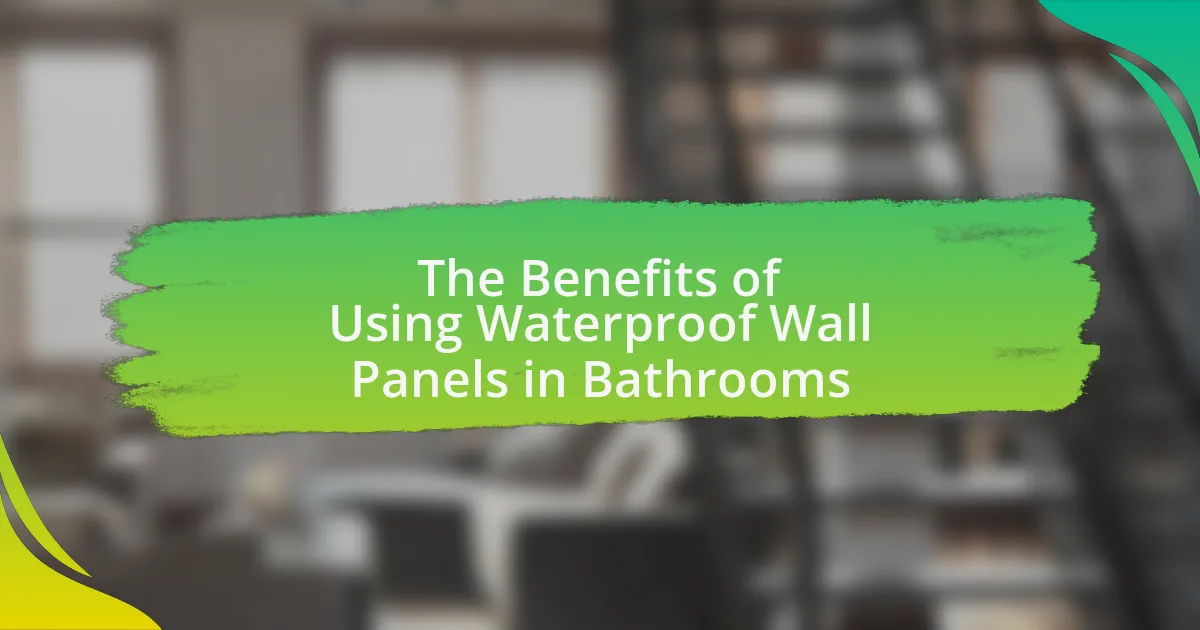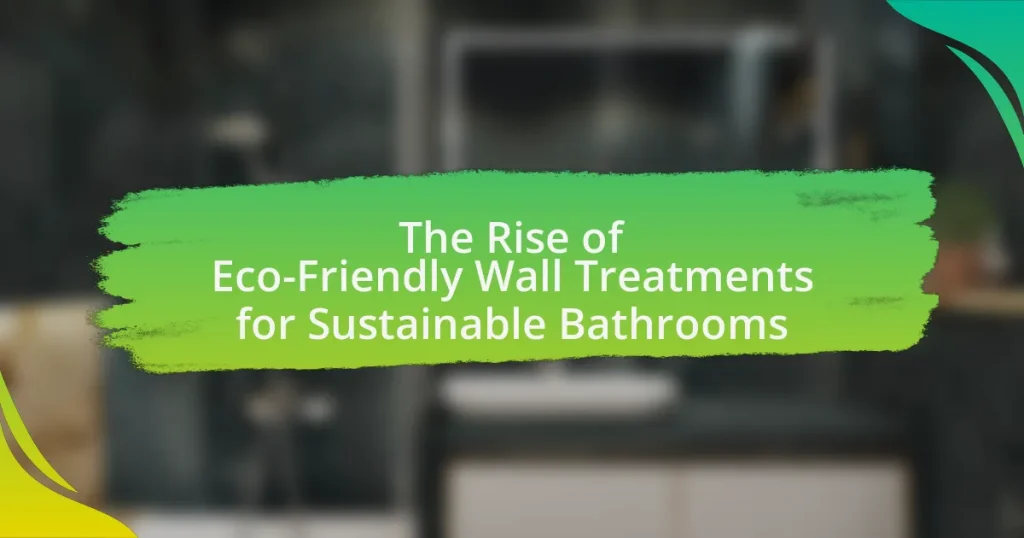Waterproof wall panels are specialized materials designed to resist moisture and prevent water damage, making them particularly suitable for bathroom environments. This article outlines the advantages of using waterproof wall panels, including their superior moisture resistance compared to traditional materials, ease of installation, and low maintenance requirements. It also discusses the various materials used in these panels, such as PVC and fiberglass, and highlights their aesthetic versatility and long-term cost savings. Additionally, the article covers installation tips, maintenance practices, and considerations for selecting the right waterproof wall panels to enhance bathroom functionality and air quality.
What are Waterproof Wall Panels and Why Use Them in Bathrooms?
Waterproof wall panels are specialized panels designed to resist moisture and prevent water damage, making them ideal for bathroom environments. These panels are typically made from materials such as PVC, fiberglass, or treated wood, which provide a barrier against water infiltration. The use of waterproof wall panels in bathrooms is essential because they help to maintain a dry and hygienic space, reducing the risk of mold and mildew growth, which can pose health risks and lead to costly repairs. Additionally, waterproof wall panels are easy to clean and maintain, offering a practical solution for high-moisture areas.
How do Waterproof Wall Panels differ from traditional wall materials?
Waterproof wall panels differ from traditional wall materials primarily in their resistance to moisture and water damage. Unlike traditional materials such as drywall or plaster, which can absorb water and lead to mold growth, waterproof wall panels are designed to repel water, making them ideal for high-humidity environments like bathrooms. This moisture resistance not only prevents structural damage but also reduces maintenance needs, as waterproof panels are easier to clean and less prone to deterioration over time.
What materials are commonly used in Waterproof Wall Panels?
Common materials used in waterproof wall panels include PVC, fiberglass, and acrylic. PVC panels are popular due to their resistance to moisture and ease of installation. Fiberglass panels offer durability and are often used in commercial settings for their strength and water resistance. Acrylic panels are lightweight and provide a smooth finish, making them suitable for residential bathrooms. These materials are specifically chosen for their ability to withstand water exposure, ensuring longevity and maintaining aesthetics in wet environments.
How does the installation process of Waterproof Wall Panels compare to other options?
The installation process of Waterproof Wall Panels is generally quicker and less labor-intensive compared to traditional options like tile or drywall. Waterproof Wall Panels often come in interlocking designs or panels that can be adhered directly to existing surfaces, reducing the need for extensive preparation and multiple materials. In contrast, tile installation requires precise cutting, grouting, and curing time, while drywall often necessitates additional waterproofing measures. This efficiency in installation can lead to lower labor costs and faster project completion, making Waterproof Wall Panels a practical choice for bathroom renovations.
What are the primary benefits of using Waterproof Wall Panels in bathrooms?
The primary benefits of using waterproof wall panels in bathrooms include moisture resistance, ease of maintenance, and aesthetic versatility. Waterproof wall panels effectively prevent water damage, mold growth, and deterioration, which are common issues in high-humidity environments like bathrooms. Additionally, these panels are easy to clean and maintain, requiring only a simple wipe-down to keep them looking new, unlike traditional materials that may require more intensive care. Furthermore, waterproof wall panels come in various designs and finishes, allowing for customization to match different bathroom styles while providing a modern look.
How do Waterproof Wall Panels enhance moisture resistance?
Waterproof wall panels enhance moisture resistance by creating a seamless barrier that prevents water penetration. These panels are typically made from materials such as PVC or fiberglass, which do not absorb water, thereby reducing the risk of mold and mildew growth. The non-porous surface of waterproof wall panels ensures that moisture cannot seep through, making them ideal for high-humidity environments like bathrooms. Additionally, their installation often involves interlocking designs or adhesive applications that further minimize gaps where moisture could enter.
What impact do Waterproof Wall Panels have on bathroom maintenance?
Waterproof wall panels significantly reduce bathroom maintenance by preventing moisture-related issues such as mold and mildew growth. These panels are designed to be impervious to water, which minimizes the risk of damage to underlying structures and finishes. As a result, homeowners experience less frequent need for repairs and cleaning, leading to lower long-term maintenance costs. Studies indicate that bathrooms with waterproof materials can reduce mold growth by up to 90%, highlighting the effectiveness of these panels in maintaining a clean and healthy environment.
How do Waterproof Wall Panels contribute to aesthetic appeal?
Waterproof wall panels enhance aesthetic appeal by offering a sleek, modern look that can mimic various materials such as wood, stone, or tile. These panels come in a variety of colors, textures, and finishes, allowing for versatile design options that can complement any bathroom decor. Their seamless installation reduces visible joints and grout lines, creating a clean and polished appearance. Additionally, the reflective surfaces of some waterproof panels can enhance lighting in the space, further elevating the overall aesthetic.
How do Waterproof Wall Panels improve bathroom functionality?
Waterproof wall panels significantly enhance bathroom functionality by providing a moisture-resistant barrier that prevents water damage and mold growth. This feature ensures that the walls remain intact and visually appealing over time, reducing the need for frequent repairs or replacements. Additionally, waterproof wall panels are easy to clean, which promotes hygiene and simplifies maintenance, making them a practical choice for high-moisture environments like bathrooms. Their installation can also lead to improved insulation and energy efficiency, contributing to a more comfortable and cost-effective space.
What role do Waterproof Wall Panels play in preventing mold and mildew?
Waterproof wall panels play a crucial role in preventing mold and mildew by creating a barrier that resists moisture penetration. These panels are typically made from materials that do not absorb water, which significantly reduces the likelihood of mold growth, as mold thrives in damp environments. Studies have shown that environments with high humidity and moisture levels are conducive to mold development, making waterproof materials essential in areas like bathrooms where water exposure is frequent. By utilizing waterproof wall panels, homeowners can effectively minimize the risk of mold and mildew, ensuring a healthier living space.
How do Waterproof Wall Panels affect air quality in bathrooms?
Waterproof wall panels positively affect air quality in bathrooms by reducing moisture accumulation, which minimizes the growth of mold and mildew. Mold and mildew thrive in damp environments, and their presence can lead to respiratory issues and other health problems. By preventing moisture penetration, waterproof wall panels help maintain a drier atmosphere, thereby improving overall air quality. Studies have shown that controlling humidity levels in bathrooms can significantly reduce airborne allergens, contributing to a healthier indoor environment.
What are the long-term cost savings associated with Waterproof Wall Panels?
Waterproof wall panels provide significant long-term cost savings primarily through reduced maintenance and repair expenses. These panels are resistant to moisture, mold, and mildew, which minimizes the need for frequent replacements or repairs that are common with traditional wall materials. For instance, studies indicate that buildings with waterproof wall systems can save up to 30% on maintenance costs over a 10-year period compared to those using conventional materials. Additionally, the durability of waterproof panels leads to lower energy costs, as they help maintain consistent indoor temperatures, reducing heating and cooling expenses.
How do Waterproof Wall Panels compare to other bathroom wall options?
Waterproof wall panels offer superior moisture resistance compared to traditional bathroom wall options like drywall, tile, or paint. Unlike drywall, which can absorb water and lead to mold growth, waterproof panels are designed to repel moisture, ensuring a longer lifespan and reduced maintenance. Additionally, while tiles can be prone to grout deterioration and require regular sealing, waterproof panels provide a seamless surface that minimizes the risk of water infiltration. This durability is supported by their construction from materials such as PVC or fiberglass, which are inherently resistant to water damage.
What are the advantages of Waterproof Wall Panels over tiles?
Waterproof wall panels offer several advantages over tiles, primarily in terms of installation, maintenance, and durability. Unlike tiles, which require grout that can absorb moisture and lead to mold growth, waterproof wall panels are seamless and non-porous, significantly reducing the risk of water damage. Additionally, the installation of waterproof wall panels is generally quicker and less labor-intensive than tiling, as they can often be adhered directly to existing walls without the need for extensive preparation. Furthermore, waterproof wall panels are easier to clean and maintain, as they do not require the same level of upkeep as tiled surfaces, which can accumulate grime in grout lines. These factors make waterproof wall panels a more efficient and hygienic choice for bathroom environments.
How do Waterproof Wall Panels stack up against paint and wallpaper?
Waterproof wall panels outperform paint and wallpaper in moisture resistance and durability. Unlike paint, which can peel or mold in humid environments, waterproof wall panels are designed to withstand high moisture levels without damage. Additionally, wallpaper can absorb moisture, leading to potential mold growth, while waterproof panels are non-porous and easy to clean. This makes them a superior choice for bathrooms, where humidity is a constant factor. Furthermore, waterproof wall panels often require less maintenance over time compared to the frequent repainting or replacing of wallpaper, providing long-term cost efficiency.
What considerations should be made when choosing Waterproof Wall Panels?
When choosing waterproof wall panels, consider material durability, ease of installation, maintenance requirements, and aesthetic appeal. Durable materials like PVC or fiberglass reinforced panels resist moisture and prevent mold growth, making them ideal for bathrooms. Ease of installation is crucial; panels that can be easily cut and fitted save time and labor costs. Maintenance requirements should also be evaluated; panels that require minimal upkeep are preferable for busy environments. Lastly, aesthetic appeal is important, as the design and color of the panels should complement the overall bathroom decor.
What factors influence the selection of Waterproof Wall Panels?
The selection of waterproof wall panels is influenced by factors such as material durability, moisture resistance, ease of installation, aesthetic appeal, and cost. Material durability ensures that the panels can withstand wear and tear, while moisture resistance is crucial for preventing mold and mildew in high-humidity environments like bathrooms. Ease of installation affects labor costs and project timelines, making certain panel types more desirable. Aesthetic appeal is important for maintaining the overall design of the bathroom, and cost considerations help determine the budget for the project. These factors collectively guide consumers in making informed decisions about waterproof wall panels.
How do design preferences affect the choice of Waterproof Wall Panels?
Design preferences significantly influence the selection of waterproof wall panels by dictating the aesthetic, texture, and color choices that align with a bathroom’s overall theme. For instance, a modern minimalist design may favor sleek, glossy panels in neutral tones, while a rustic style might opt for textured panels that mimic natural wood or stone. These preferences are often guided by current design trends, personal taste, and the desired ambiance of the space, leading consumers to choose materials that not only provide functionality but also enhance visual appeal.
What are the price ranges for different types of Waterproof Wall Panels?
The price ranges for different types of waterproof wall panels typically vary from $1 to $10 per square foot. For example, basic PVC panels can cost around $1 to $3 per square foot, while higher-end options like fiberglass-reinforced panels may range from $5 to $10 per square foot. These prices reflect the material quality and durability, with more expensive panels often providing better resistance to moisture and easier maintenance.
What installation tips should be followed for Waterproof Wall Panels?
To install waterproof wall panels effectively, ensure that the surface is clean, dry, and free from any debris before application. Proper surface preparation is crucial as it allows for better adhesion and prevents moisture infiltration. Additionally, use a high-quality adhesive specifically designed for waterproof materials to secure the panels firmly. This type of adhesive is essential for maintaining the integrity of the installation in humid environments like bathrooms. Furthermore, always follow the manufacturer’s guidelines regarding panel alignment and spacing to achieve a seamless finish. These guidelines are based on industry standards that emphasize the importance of correct installation techniques to maximize the durability and performance of waterproof wall panels.
How can homeowners ensure a successful installation of Waterproof Wall Panels?
Homeowners can ensure a successful installation of waterproof wall panels by meticulously preparing the surface and following manufacturer guidelines. Proper surface preparation involves cleaning, leveling, and repairing any existing damage to the walls, which is crucial for optimal adhesion and performance. Additionally, homeowners should carefully read and adhere to the installation instructions provided by the manufacturer, as these guidelines often include specific recommendations for tools, adhesives, and techniques that enhance the effectiveness of the panels. Following these steps minimizes the risk of water damage and maximizes the longevity of the installation.
What common mistakes should be avoided during installation?
Common mistakes to avoid during the installation of waterproof wall panels in bathrooms include improper surface preparation, inadequate sealing of joints, and neglecting to follow manufacturer guidelines. Proper surface preparation ensures that the panels adhere correctly and prevents moisture infiltration, which can lead to mold growth. Inadequate sealing of joints can create gaps that allow water to penetrate, undermining the waterproofing benefits. Following manufacturer guidelines is crucial, as these instructions provide specific requirements for installation that ensure optimal performance and longevity of the panels.
What are the best practices for maintaining Waterproof Wall Panels?
To maintain waterproof wall panels effectively, regularly clean them with a mild detergent and water to prevent mold and mildew buildup. This practice ensures the panels remain hygienic and visually appealing. Additionally, inspect the seams and joints for any signs of wear or damage, as these areas are critical for maintaining waterproof integrity. Promptly addressing any issues, such as resealing or repairing damaged sections, helps prolong the lifespan of the panels. Furthermore, avoid using abrasive cleaners or tools that could scratch the surface, as this may compromise their waterproof properties. Regular maintenance, including these practices, is essential for optimal performance and durability of waterproof wall panels in bathrooms.
How can regular cleaning extend the lifespan of Waterproof Wall Panels?
Regular cleaning can significantly extend the lifespan of waterproof wall panels by preventing the buildup of mold, mildew, and grime that can degrade the material over time. Consistent maintenance removes contaminants that can cause surface deterioration and structural damage, ensuring that the panels remain intact and functional. Studies indicate that surfaces kept clean and dry are less likely to experience wear and tear, which supports the longevity of waterproof materials.
What products are recommended for maintaining Waterproof Wall Panels?
To maintain waterproof wall panels, it is recommended to use a mild detergent solution for regular cleaning, along with silicone sealants for ensuring watertight seams. Mild detergents effectively remove dirt and grime without damaging the panels, while silicone sealants help to prevent moisture infiltration at joints and edges. Regular maintenance with these products can prolong the lifespan of waterproof wall panels and maintain their aesthetic appeal.



